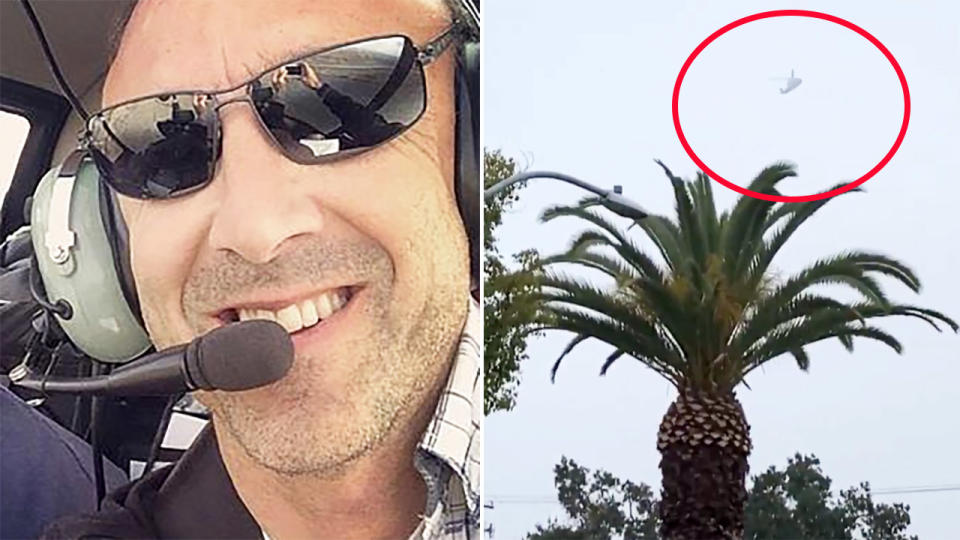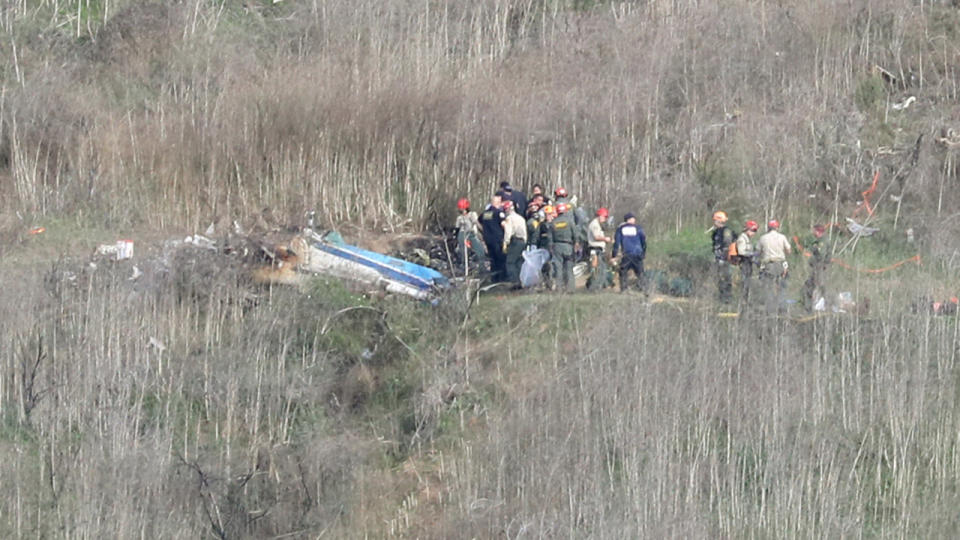Pilot's concerning final message as footage of Kobe Bryant helicopter emerges
Footage that appears to show Kobe Bryant’s helicopter circling above the ground some 15 minutes before the fatal crash has been posted online after investigators called for the public’s help to try to piece together exactly what went wrong.
The video, posted on Twitter by a user who says they live in the Los Angeles suburb of Glendale where Bryant’s helicopter went down on Sunday, shows a chopper moving slowly through the sky as morning fog shrouds the area.
DEVASTATING: The tragic irony in Kobe's death in helicopter crash
According to flight records, Bryant’s helicopter circled the area for about 10 minutes while awaiting instructions.
“I try and video/photograph all the weird stuff happening above my house in Glendale, CA,” the Twitter user wrote.
“Unfortunately this morning I didn’t realise I was filming the helicopter Kobe Bryant, his daughter and others were in 31 minutes before they crashed. RIP”.
I try and video /photograph all the weird stuff happening above my house in Glendale,CA. Unfortunately this morning I didn’t realize I was filming the helicopter Kobe Bryant, his daughter and others were in 31 minutes before they crashed . RIP pic.twitter.com/8zdiplvEbv
— THEIR ONLY DREAMS (@theironlydreams) January 27, 2020
Reuters has reportedly confirmed the footage was filmed at 9.29am in Glendale on the morning of the crash.
The news agency reportedly cited metadata from the user’s phone to verify the footage.
Video company Storyful has also reportedly said they believe the footage is of Bryant’s helicopter.
Investigators call for public’s help
In a sign limited visibility was of particular interest to investigators as reports indicated foggy conditions, NTSB board member Jennifer Homendy appealed to the public to come forward with any photographs that might help document local weather conditions at the time of the crash.
The veteran pilot at the helm of Bryant’s chopper had tried to avoid fog so heavy that it had grounded police choppers, authorities said on Tuesday.
But even experienced pilots may have only seconds to act when they are blinded by weather, an expert said as investigators examined the wreckage for clues.
The Los Angeles County coroner's office, meanwhile, said that all nine bodies have been recovered, and it is working to identify them.

While the investigation into the cause of the wreck was just beginning, experts and armchair pilots alike flooded social media and the airwaves with speculation, some of them suggesting that the pilot had become disoriented in the dense fog that had settled along part of the flight path.
The chartered Sikorsky S-76B was a luxury twin-engine aircraft often used by Bryant in traffic-jumping hops around the notoriously congested LA area.
It was heading from John Wayne Airport in Orange County to Camarillo Airport in Ventura County when it crashed in Calabasas.
The 41-year-old former Los Angeles Laker, his 13-year-old daughter, Gianna, and the other passengers were heading to Bryant's Mamba Sports Academy, a youth sports centre in Thousand Oaks where Gianna was going to play in a basketball tournament.
Also killed were John Altobelli, 56, longtime head coach of Southern California's Orange Coast College baseball team; his wife, Keri; and daughter, Alyssa, who played on the same basketball team as Bryant's daughter; and Christina Mauser, a girls' basketball coach at a Southern California elementary school.
The pilot, Ara Zobayan, was chief pilot for the craft's owner, Island Express Helicopters. He also was a flight instructor, had more than 8000 hours of flight time and had flown Bryant and other celebrities several times before, including Kylie Jenner.

Claims pilot became confused
Randy Waldman, a helicopter flight instructor who lives in Los Angeles, said the radar tracking data he has seen leads him to believe the pilot got confused in the fog and went into a fatal dive.
“Once you get disoriented your body senses completely tell you the wrong thing. You have no idea which way is up or down,” he told AP.
“If you're flying visually, if you get caught in a situation where you can't see out the windshield, the life expectancy of the pilot and the aircraft is maybe 10, 15 seconds.'“
Some experts raised questions of whether the helicopter should have even been flying. The weather was so foggy that the Los Angeles Police Department and the county sheriff's department had grounded their own choppers.
“He could have turned around and gone back to a safer place with better visibility,” Waldman said.
However, '“a lot of times somebody who's doing it for a living is pressured to get their client to where they have to go,” he said. '“They take chances that maybe they shouldn't take.'“
The helicopter was flying around Burbank, just north of Los Angeles, when the pilot received air traffic control permission to use special visual flight rules, allowing the helicopter to fly in less-than-optimal visibility and weather.
Zobayan was told to follow a freeway and stay at or below 2,500 feet (762 meters), according to radio traffic.

Pilot’s concerning final message
The pilot didn't seem overly concerned, though at one point he asked air traffic controllers to provide “flight following” guidance but was told the helicopter was too low for that radar assistance.
About four minutes later, the pilot said he was climbing to avoid a cloud layer, Homendy said.
When controllers asked Zobayan what he was planning, Homendy said they received “no reply”.
It was his last message before the helicopter slammed into a hillside and burst into flames.
Hormendy said investigators would look at everything, from the pilot's history and actions to the condition of the helicopter.
“We look at man, machine and the environment,” she said. “And weather is just a small portion of that.”
Jerry Kidrick, a retired Army colonel who flew helicopters in Iraq and now teaches at Embry-Riddle Aeronautical University in Prescott, Arizona, said the helicopter's rapid climb and fast descent suggest the pilot was disoriented.
“It's one of the most dangerous conditions you can be in,” Kidrick said.
“Oftentimes, your body is telling you something different than what the instruments are telling you.”
On Monday, NTSB investigators scoured the area to collect evidence, and Los Angeles County sheriff's deputies on horseback patrolled the brushy Calabasas hillside. Homendy said the NTSB expected to be on the scene for five days.
“It was a pretty devastating accident scene,” she said of the widespread wreckage.
“A piece of the tail is down the hill. The fuselage is on the other side of that hill. And then the main rotor is about 100 yards (91 meters) beyond that.”
with AP and Reuters
